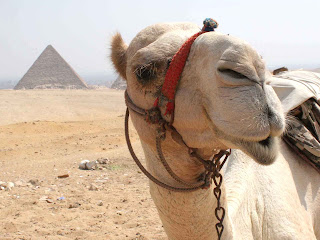1. Kangaroo
A kangaroo is an animal found only in Australia, although it has a smaller relative, called a wallaby, which lives on the Australian island of Tasmania and also in New Guinea.
Kangaroos eat grass and plants. They have short front legs, but very long, and very strong back legs and a tail. These are used for sitting up and for jumping. Kangaroos have been known to make forward jumps of over eight metres, and leap across fences more than three metres high. They can also run at speeds of over 45 kilometres per hour.
The largest kangaroos are the Great Grey Kangaroo and the Red Kangaroo. Adult grow to a length of 1.60 metres and weigh over 90 kilos.
Kangaroos are marsupials. This means that the female kangaroo has an external pouch on the front of her body. A baby kangaroo is very tiny when it is born, and it crawls at once into this pouch where it spends its first five months of life.
2. What Is Thunder and Lightning?
Lightning is a sudden, violent fl ash of electricity between a cloud and the ground, or from cloud to cloud. A lightning fl ash, or bolt, can be several miles long. It is so hot, with an average temperature of 34,000° Centigrade, that the air around it suddenly expands with a loud blast. This is the thunder we hear.
Lightning occurs in hot, wet storms. Moist air is driven up to a great height. It forms a type of cloud called cumulonimbus. When the cloud rises high enough, the moisture freezes and ice crystals and snowfl akes are formed. These begin to fall, turning to rain on the way down. This rain meets more moist air rising, and it is the friction between them which produces static electricity. When a cloud is fully charged with this electricity, it discharges it as a lightning fl ash.
3. Platypus; a report text
Many people call platypus duckbill because this animal has a bill like duckbill. Platypus is a native Tasmania and southern and eastern Australia.
Platypus has a flat tail and webbed feet. Its body length is 30 to 45cm and covered with a thick, and woolly layer of fur. Its bill is detecting prey and stirring up mud. Platypus' eyes and head are small. It has no ears but has ability to sense sound and light.
Platypus lives in streams, rivers, and lakes. Female platypus usually dig burrows in the streams or river banks. The burrows are blocked with soil to protect it from intruders and flooding. In the other hand, male platypus does not need any burrow to stay.
4. The Camel
The camel is a large, strong desert animal. Camels can travel great distances across hot, dry deserts with little food or water. They walk easily on soft sand and carry people and heavy hump. The hump is a large lump of fat providing energy if food is hard to fi nd.
There are two chief kinds of camels: (1) the Arabian camel also loads to places that have no roads. Camels also serve the people of the desert in many other ways.
The camel carries its own built-in food supply on its back in the form of a called dromedary, which has one hump, and (2) Bactrian camel, which has two humps.
5. The Red Bird Of Paradise
An Indonesian endemic, the Red Bird of Paradise is distributed to lowland rainforests of Waigeo and Batanta islands of West Papua. This species shares its home with another bird of paradise, the Wilson's Bird of Paradise. Hybridisation between these two species are expected but not recorded yet.
The Red Bird of Paradise, Paradisaea rubra is a large, up to 33cm long, brown and yellow bird of paradise with a dark brown iris, grey legs and yellow bill. The male has an emerald green face, a pair of elongated black corkscrew-shaped tail wires, dark green feather pompoms above each eye and a train of glossy crimson red plumes with whitish tips at either side of the breast.
The male measures up to 72 cm long, including the ornamental red plumes that require at least six years to fully attain. The female resembles the male but is smaller in size, with a dark brown face and has no ornamental red plumes. The diet consists mainly of fruits, berries and arthropods.
6. KOMODO DRAGON
 Komodo,
or commonly called Komodo dragons (Varanuskomodoensis). Komodo is the
world’s largest lizard species that live on the island of Komodo, Rinca,
Flores, Gili Motang,and Gili Dasami in Nusa Tenggara.
Komodo,
or commonly called Komodo dragons (Varanuskomodoensis). Komodo is the
world’s largest lizard species that live on the island of Komodo, Rinca,
Flores, Gili Motang,and Gili Dasami in Nusa Tenggara.In the wild, an adult dragons usually weighs around 70 kilograms. The largest verified wild specimen was 3.13 metres long and weighed 166 kilograms. Komodo dragon has a tail as long as its body, and around 60 pieces of sharp serrated teeth along about 2.5 cm.
Komodo has gray scaly skin, a pointed snout, powerful limbs and a muscular tail. Komodo dont have the sense of hearing, although having the ear hole. They use their keen sense of smell to locate decaying animal remains from several miles away. They also hunt other lizards as well as large mammals and are sometimes cannibalistic.
Komodo dragons are carnivores. It is able to locate its prey using its keen sense of smell, which can locate a dead or dying animal from a range of up to 9.5 kilometres. Komodo dragons eat by tearing large chunks of flesh and swallowing them whole while holding the carcass down with their forelegs. Komodo have saliva that has deadly bacteria in it. If dragons bite dont directly kill the their prey and prey that can escape this pesky generally prey will die within one week of infection.





Tidak ada komentar:
Posting Komentar